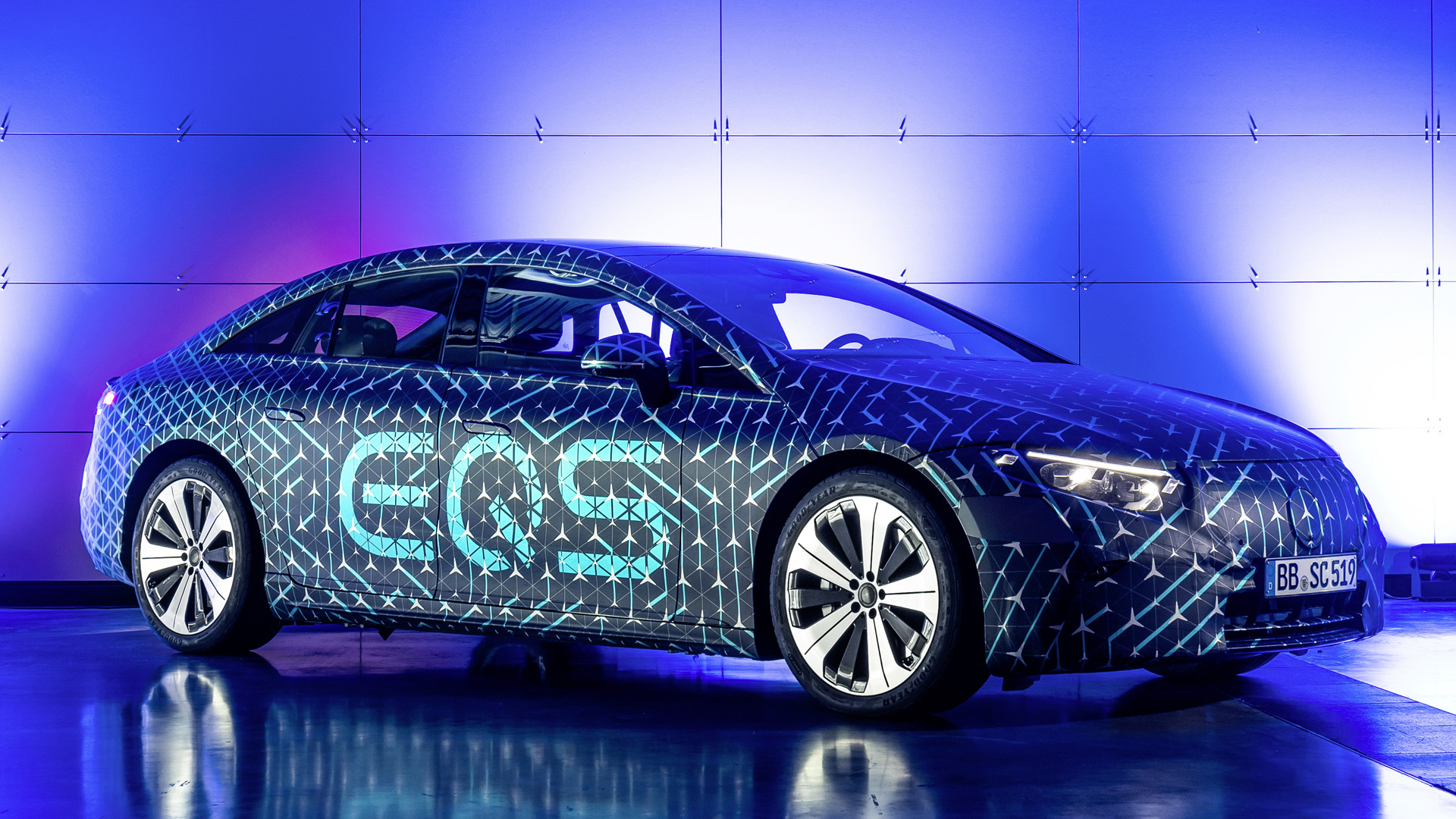

It’s time to stop talking about the new Mercedes-Benz EQS’ hyperscreen. Yes, it is 56 inches of infotainment, yes it completely dominates the EV’s cabin, but it’s also probably the least impressive thing in the entire car in terms of raw engineering. We know Mercedes can make big touchscreens and intuitive infotainment systems, but those aren’t as futuristic as people want us to pretend it is—there are so many more interesting things to talk about when it comes to Merc’s new luxury sedan.
For example, Mercedes really likes flexing on drag coefficient, which isn’t a stupid thing to do at all, especially when it comes to electric vehicles. Think about it this way: if you’re pushing through the air on the highway, your mileage can plummet drastically compared to if you’re cruising in a semi-truck’s slipstream. The truck is punching a hole in the air for you. Most drivers know this, but does the little display on the dash that shows “range to empty” know that? Mercedes has put a ton of work into things like that in the EQS, yet it’s not making as much noise about it compared to that flipping giant piece of glass in the dashboard.

The EQS looks like a relatively pedestrian sedan. There’s nothing ludicrous about it, nothing overstated in a supercar-ish way but it has a drag coefficient that defies expectations. When Tesla announced its Model 3 had a drag coefficient of just 0.23, it was rightly pleased with itself. Tesla gets a lot of crap for its build quality, but it’s great at engineering to improve performance.
Porsche did one better with the Taycan, which has a drag coefficient of just 0.22. That’s impressive and it adds to the Taycan’s credentials as a real Porsche car, something engineered to extract the maximum performance. Whisper it, though, because the unassumingly-shaped sedan Merc just dropped has a reported drag coefficient of 0.20. You can’t beat that unless you somehow find a GM EV1, which definitely is not a production car.
That’s 0.02 better than the Taycan, in a car that also claims to potentially offer a range in excess of that critical 400-mile mark. Mercedes’ latest estimate claims 770 kilometers, which is roughly 478 miles, though that’s on Europe’s WLTP rather than an EPA-verified figure. We’ll wait for the full specs on that, but if that drag figure is right, and there’s a decent chance that it is, it’ll most likely exceed its range, just like the Taycan.
So yes, this car is literally smooth. All over. Like a speed cyclist’s legs, it has been polished for efficiency and that’s extremely cool, especially in a car that—if you choose the all-wheel-drive version with motors on the front and rear axle—has up to 516 horsepower. That’s a lot, especially in a sedan that’s limited to 130 mph and not designed for the track. Should you forego twin electric units, a single one still takes you to a not-inconsiderable 329 horsepower.

The interior of the EQS may be luxurious, but evidently, that’s not a mask to hide failings beneath the hood, this is a serious piece of tech at its most basic principles: the chassis is efficient, the drivetrain is powerful, it’s a good car.
It also packs other clever features. Most notable, the up-to-108kWh battery has a fast-charging mode where it can self-regulate its temperature, preserving the battery’s life so it can continuously receive the highest voltage. The battery itself, of course, isn’t shoddy either and Mercedes is banking on that to offer a battery warranty (for Europe and U.S. customers) that covers “loss of capacity” as well as any significant failures up to 155,000 miles.
The electric motors are also pretty clever. Motors used in cheap EVs produce over 85 percent efficiency and are pretty simple—they definitely have fewer moving parts than an engine—but optimizing them is a separate problem. The fact that Mercedes has added a needle-shaped pin-fin structure on the inverter in order to cool it more efficiently is very smart. That’s the kind of engineering that separates a luxury EV’s powertrain from well, the more affordable ones.
Like any decent EV, it’s also got some environmental creds: the cable ducts are made of recycled plastics, floor coverings are made of recycled yarn, the aluminum used in the inside of the hood is certified to be sustainably produced. That’s all nice and not to be sniffed at; it shows a level of detail that you’d expect for a vehicle we don’t actually know the price of yet but is likely to be in excess of $100,000 when it goes on sale in the U.S.
So stop looking at that huge screen, please. It’s not the only thing to see here.
Got a story tip? Mail me at hazel@thedrive.com